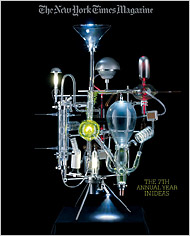Ambiguity Promotes Liking (New York Times Magazine, Year in Ideas)
Is it true that familiarity breeds contempt? A psychology study published this year concludes that the answer is yes. It seems we are inclined to interpret ambiguous information about someone optimistically, assuming we will get along. We are usually let down, however, when we learn more.
A team of researchers, led by Michael I. Norton of Harvard Business School, looked at online daters’ opinions of people they were about to meet for the first time and compared those ratings with another group’s post-date impressions. Before the date, based on what little information the daters saw online, most participants rated their prospective dates between a 6 and a 10 on a 10-point scale, with nobody giving a score below a 3. But post-date scores were lower, on average, and lots of people deemed their date a total dud.
Why? For starters, initial information is open to interpretation. “And people are so motivated to find somebody they like that they read things into the profiles,” Norton says. If a man writes that he likes the outdoors, his would-be mate imagines her perfect skiing companion, but when she learns more, she discovers “the outdoors” refers to nude beaches. And “once you see one dissimilarity, everything you learn afterward gets colored by that,” Norton says.
The letdown from getting more information isn’t true just for romance. In one experiment, the researchers showed college students different numbers of randomly selected traits and asked them to rate how much they’d like the person described. For the most part, the more traits participants saw, the less they said they would like the other person. But another group of students had overwhelmingly said they would like people more after learning more about them.
We make this mistake, the researchers say, largely because we can all recall cases of more knowledge leading to more liking. “You forget the people in your third-grade class you didn’t like; you remember the people you’re still friends with,” Norton explains.
This article written by Marina Krakovsky appeared in the 2007 Year in Ideas issue of New York Times Magazine.








